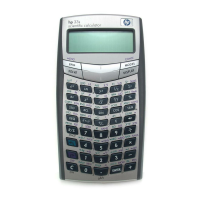13–8 Programming Techniques
File name 33s-E-Manual-1008-Publication(1st).doc Page : 386
Printed Date : 2003/10/8 Size : 13.7 x 21.2 cm
Program Lines:
(In RPN mode)
Description
.
.
.
Calculates the correction for X
guess
.
Adds the correction to yield a new X
guess
.
<
Tests to see if the correction is significant.
Goes back to start of loop if correction is significant.
Continues if correction is not significant.
Displays the calculated value of X.
.
.
.
Line T0009 calculates the correction for X
guess
. Line T0013 compares the absolute
value of the calculated correction with 0.0001. If the value is less than 0.0001
("Do If True"), the program executes line T0014; if the value is equal to or greater
than 0.0001, the program skips to line T0015.
Flags
A flag is an indicator of status. It is either set (true) or clear (false). Testing a flag is
another conditional test that follows the "Do if true" rule: program execution
proceeds directly if the tested flag is set, and skips one line if the flag is clear.
Meanings of Flags
The HP 33s has 12 flags, numbered 0 through 11. All flags can be set, cleared,
and tested from the keyboard or by a program instruction. The default state of all
12 flags is clear. The three–key memory clearing operation described in appendix
B clears all flags. Flags are not affected by
¹
¡
{
} {
}.
Flags 0, 1, 2, 3, and 4 have no preassigned meanings. That is, their
states will mean whatever you define it to mean in a given program. (See the
example below.)

